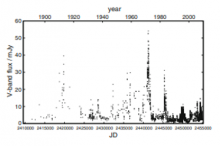
Abstract
We model the binary black hole system OJ287 as a spinning primary and a non-spinning secondary. It is assumed that the primary has an accretion disk which is impacted by the secondary at specific times. These times are identified as major outbursts in the light curve of OJ287. This identification allows an exact solution of the orbit, with very tight error limits. Nine outbursts from both the historical photographic records as well as from recent photometric measurements have been used as fixed points of the solution: 1913, 1947, 1957, 1973, 1983, 1984, 1995, 2005 and 2007 outbursts. This allows the determination of eight parameters of the orbit. Most interesting of these are the primary mass of 1.84x10^{10} Solar masses, the secondary mass 1.46x10^8 Solar masses, major axis precession rate 39.1 degrees per period, and the eccentricity of the orbit 0.70. The dimensionless spin parameter is 0.28+-0.01 (1 sigma). The last parameter will be more tightly constrained in 2015 when the next outburst is due. The outburst should begin on 15 December 2015 if the spin value is in the middle of this range, on 3 January 2016 if the spin is 0.25, and on 26 November 2015 if the spin is 0.31. We have also tested the possibility that the quadrupole term in the Post Newtonian equations of motion does not exactly follow Einstein's theory: a parameter $q$ is introduced as one of the 8 parameters. Its value is within 30% (1 sigma) of the Einstein's value q = 1. This supports the no-hair theorem of black holes within the achievable precision. We have also measured the loss of orbital energy due to gravitational waves. The loss rate is found to agree with Einstein's value with the accuracy of 2% (1 sigma). There is a possibility of improving the accuracy of both quantities using the exact timing of the outburst on 21 July 2019.